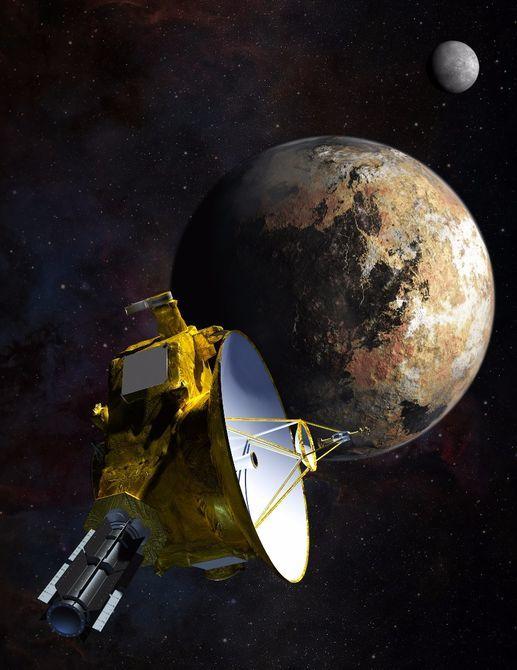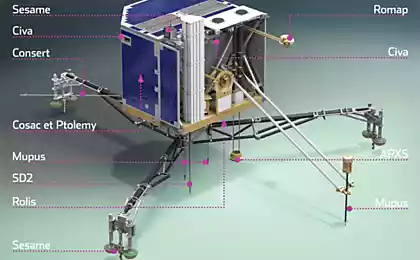702
To probe "New horizons" is selected a new target for research
The operation of the spacecraft "New horizons" continues. After the historic flyby of Pluto on July 14 of this year, the space Agency NASA chose a new potential destination of its unmanned space probe. This place is the 2014 MU69 planetoid, located 1.5 billion kilometers from the orbit of Pluto. To get to that ice representative of the early history of the Solar system, the probe will take more than three years.

Located in the Kuiper belt object 2014 MU69 was nicknamed "PT1" or "Potential Target 1" (Potential goal number 1), given to him by the command "New horizons". According to NASA, the diameter of this outer body is less than 45 kilometers, however, it is about 10 times larger and 1000 times heavier than normal asteroid. The small size of this object makes it interesting for scientists, who believe that PT1 is the residual or "building blocks" of the Solar system who find themselves on the margins of the dark, cold, deep space and not much has undergone changes over the past 4.6 billion years.
PT1 was one of several potential targets that were considered by the command "New horizons" after serious studies of the issue in 2011. Ground-based telescopes are unable with sufficient effectiveness to choose other candidates, so in the case entered the space telescope "Hubble". He found five valid targets, then their number was reduced to two. And now the choice is made definitively.
Despite the fact that New horizons will reach PT1 after 1 January 2019, the team of scientists had to choose aim in a hurry because for the beginning of the movement the probe must be done four orbital course correction in late October and early November. At any other time, the machine will have to spend much more fuel to further the mission proved successful.
After the maneuver 2007 using the gravitational forces of Jupiter New horizons has a top speed of 83 600 km/h. only 14 July of this year, after nine and a half years of space travel through deep space, the device flew past Pluto at a distance of 12 500 kilometres from the planet at a speed of 14 km/sec, which allowed him to examine in detail this mysterious for the scientists of the world. At the moment the probe is 4.9 billion miles from Earth and over the next 15 months in will send home information about your flight.

As with most space missions NASA's deep space exploration, "New horizons" was planned and developed taking into account the possibility of additional missions after completing its main task. It has extra tanks gerasimovym fuel its nuclear generator is designed for continuous operation for many years, communication systems are designed taking into account distance behind the orbit of Pluto, and to operate its scientific instruments require even less light than the reaches of Pluto.
NASA indicates that the decision to visit PT1 is still preliminary and require formal approvals before the probe will begin orbital maneuvers. The following year, the team "New horizons" must prepare a proposal to be considered by an independent team of experts. If the project gets the green light, the probe team will begin preparations for a new scientific mission.
"2014 MU69 is an excellent choice. First, it refers to the most ancient space objects in the Kuiper belt, and secondly, a mission to the planetoid fit into a ten-year program of NASA Decadal Survey", — said the head of the project "New horizons" Alan stern of the southwest research Institute (USA, Texas).

The way "New horizons" to the new purpose
"Moreover, the flight to this object in the Kuiper belt will require a much lower fuel costs (compared to other candidates). Enough fuel to fly past the planetoid, and to conduct research, and to unforeseen circumstances also fuel enough." published
P. S. And remember, only by changing their consumption — together we change the world! ©
Source: hi-news.ru/space/dlya-zonda-novye-gorizonty-vybrana-novaya-cel-dlya-issledovanij.html

Located in the Kuiper belt object 2014 MU69 was nicknamed "PT1" or "Potential Target 1" (Potential goal number 1), given to him by the command "New horizons". According to NASA, the diameter of this outer body is less than 45 kilometers, however, it is about 10 times larger and 1000 times heavier than normal asteroid. The small size of this object makes it interesting for scientists, who believe that PT1 is the residual or "building blocks" of the Solar system who find themselves on the margins of the dark, cold, deep space and not much has undergone changes over the past 4.6 billion years.
PT1 was one of several potential targets that were considered by the command "New horizons" after serious studies of the issue in 2011. Ground-based telescopes are unable with sufficient effectiveness to choose other candidates, so in the case entered the space telescope "Hubble". He found five valid targets, then their number was reduced to two. And now the choice is made definitively.
Despite the fact that New horizons will reach PT1 after 1 January 2019, the team of scientists had to choose aim in a hurry because for the beginning of the movement the probe must be done four orbital course correction in late October and early November. At any other time, the machine will have to spend much more fuel to further the mission proved successful.
After the maneuver 2007 using the gravitational forces of Jupiter New horizons has a top speed of 83 600 km/h. only 14 July of this year, after nine and a half years of space travel through deep space, the device flew past Pluto at a distance of 12 500 kilometres from the planet at a speed of 14 km/sec, which allowed him to examine in detail this mysterious for the scientists of the world. At the moment the probe is 4.9 billion miles from Earth and over the next 15 months in will send home information about your flight.

As with most space missions NASA's deep space exploration, "New horizons" was planned and developed taking into account the possibility of additional missions after completing its main task. It has extra tanks gerasimovym fuel its nuclear generator is designed for continuous operation for many years, communication systems are designed taking into account distance behind the orbit of Pluto, and to operate its scientific instruments require even less light than the reaches of Pluto.
NASA indicates that the decision to visit PT1 is still preliminary and require formal approvals before the probe will begin orbital maneuvers. The following year, the team "New horizons" must prepare a proposal to be considered by an independent team of experts. If the project gets the green light, the probe team will begin preparations for a new scientific mission.
"2014 MU69 is an excellent choice. First, it refers to the most ancient space objects in the Kuiper belt, and secondly, a mission to the planetoid fit into a ten-year program of NASA Decadal Survey", — said the head of the project "New horizons" Alan stern of the southwest research Institute (USA, Texas).

The way "New horizons" to the new purpose
"Moreover, the flight to this object in the Kuiper belt will require a much lower fuel costs (compared to other candidates). Enough fuel to fly past the planetoid, and to conduct research, and to unforeseen circumstances also fuel enough." published
P. S. And remember, only by changing their consumption — together we change the world! ©
Source: hi-news.ru/space/dlya-zonda-novye-gorizonty-vybrana-novaya-cel-dlya-issledovanij.html























